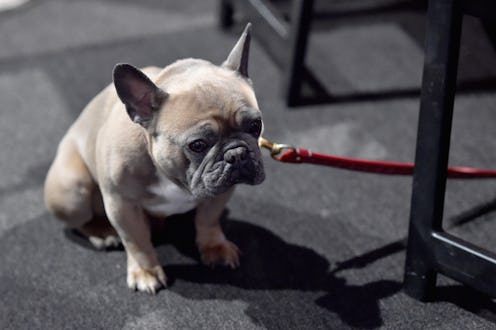
Anxiety, it's not just for humans. If you've ever wondered: Does my dog have anxiety? It's important to know that pets can get anxious too, and there are some signs to watch for so you can help Fido feel better. Just like their human parents, dogs can develop anxiety, with separation anxiety being the most form of anxiety in dogs. What's more, certain breeds of dogs are more prone to anxiety than others, according to PetMD.
"Profound fear and withdrawal of unknown cause (so called idiopathic fear and withdrawal) has also been noted in certain dog breeds, including the Siberian Husky, German Shorthaired Pointer, Greyhound, Chesapeake Bay Retriever, Bernese Mountain Dog, Great Pyrenees, Border Collie, and Standard Poodle, among others," PetMD explained. "There appears to be a strong familial component, with the likelihood of a genetic influence."
Dogs instinctually process their environments looking for danger. In an anxious dog, this behavior can manifest as excessive neediness — like wanting to be attached to you at all times — and destructive behavior when you're away from home. While dogs generally begin to develop anxiety between 12 and 36 months, it can happen at any age. Symptoms include trembling, hiding, reduced activity, and escape behaviors.
If you leave your dog home alone, and return to find that Fido has redecorated, your dog is likely anxious about your being away. "This is separation anxiety — the excessive chewing to relieve the stress it feels; continual barking; pacing; whining," Victoria Stilwell, author and dog trainer, told Sandy Eckstein for WebMD. "Sometimes, if it’s really excessive, a dog will chew through walls. I’ve had dogs jump through windows, through glass, to get outside. Most of the destruction is centered on points of exit."
Anxiety in dogs can also manifest as aggression when a dog feels like it needs to defend itself even if there isn't any danger present. Stilwell explained that behavior modification training can help your dog replace its fears and anxieties with positive associations. "This is where food plays a really powerful role," she said. "You’re actually training the brain to function in a different way. Because the dog’s sense of smell is immeasurably superior to ours, when you activate that sense of smell, you can deactivate the emotion of fear and anxiety."
Just like in humans, your dog can develop anxiety for a number of reasons such as illness, a traumatic experience, lack of socialization as a puppy, spending time in a shelter, or being re-homed multiple times, PetMD explained. Once you identify that your dog has anxiety, it's important to talk with your vet or an animal behavioralist to develop a treatment plan that's best for you and Fido.
"If your veterinarian diagnoses a simple fear, anxiety, or phobia, a prescribed medication may be all that is needed," PetMD noted. "But your doctor will most likely make recommendations based on your individual dog, the fear trigger, and types of behavioral techniques that can be used to alleviate your dog's fears and anxieties."
Things you can do at home to relieve your dog's anxiety include making a special space just for Fido where he can feel safe when you leave, and playing music. I always leave music on for my dog when I'm away, and the Washington Post reported that shelter dogs who listened to Canine Lullabies, by music legend Terry Woodford, adjusted better than other dogs.
Canine Lullabies even comes with a money-back guarantee if it doesn't calm your dog. If you want to see the magic in action, there's actually a video of this music calming down 50 shelter dogs in less than two minutes, so it might be worth a try. Overall, dealing with an anxious dog can be challenging, and it can cost you a lot of furniture. However, the sooner you identify the cause of Fido's anxiety, the sooner you can work up a treatment plan that will help you both feel better.